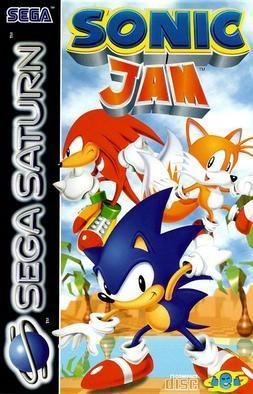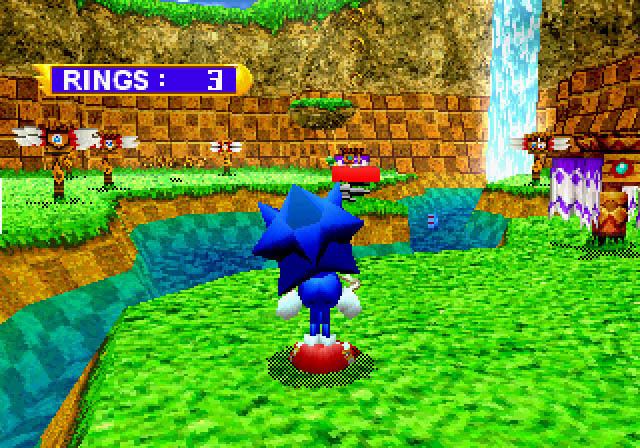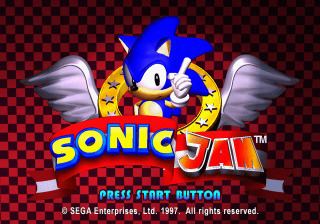9 /10 1 Votes9
Genre(s) Platform | 4.5/5 Emuparadise Initial release date 20 June 1997 | |||||||||||||||||||||||||||||||||
 | ||||||||||||||||||||||||||||||||||
Artist(s) Kazuyuki HoshinoYuji Uekawa Composer(s) Masaru SetsumaruKenichi Tokoi Mode(s) Single-player, multiplayer Similar Sonic the Hedgehog games, Sonic Team games, Platform games | ||||||||||||||||||||||||||||||||||
Sonic jam review for the sega saturn
Sonic Jam is a compilation video game developed by Sonic Team and published by Sega for the Sega Saturn. It was first released in Japan in June 1997, and in North America and Europe two months later. A port was also released for the Game.com handheld console exclusively in North America in July 1998. The game contains the first four main Sonic the Hedgehog titles which were originally released on the Mega Drive/Genesis: Sonic the Hedgehog, Sonic the Hedgehog 2, Sonic the Hedgehog 3, and Sonic & Knuckles. In addition, the game includes a 3D environment called "Sonic World", which acts as an interactive museum consisting of Sonic the Hedgehog-related content.
Contents
- Sonic jam review for the sega saturn
- Sonic jam sega saturn
- Gameplay
- Development and release
- Reception
- References

Development of the game begun after the release of Nights into Dreams... in July 1996, and was officially revealed at the 1997 Tokyo Game Show as part of a project to increase market awareness of both Sega and the Sonic the Hedgehog brand. The game received mostly positive reviews upon release; "Sonic World" was praised for its wide range of information and unlockable content, however its graphics gathered mixed responses. Regarding the compilation itself, critics praised its value for money; however, some criticised the exclusion of Sonic CD and Sonic Spinball.

Sonic jam sega saturn
Gameplay

Sonic Jam is a compilation video game which contains the first four Sonic the Hedgehog titles released on the Mega Drive: Sonic the Hedgehog, Sonic the Hedgehog 2, Sonic the Hedgehog 3, and Sonic & Knuckles. All four are nearly identical to the original Mega Drive releases, with the exception of minor bug fixes. Furthermore, Sonic Jam emulates Sonic & Knuckles' "lock-on technology"—a special feature that allows the player to merge elements of Sonic & Knuckles into previous games, resulting in slight changes to the level design as well as the choice to play as Knuckles the Echidna in Sonic the Hedgehog 2 and Tails in Sonic & Knuckles.

The four games can be played with three difficulty modes: Normal, Easy, and Original. Original mode is unchanged from the Mega Drive games, Normal mode slightly alters the stage layouts to create a unique (often less difficult) experience, and Easy mode incorporates extra platforms and removes many potential challenges (including entire levels). New features include the ability to spindash in the first Sonic the Hedgehog and to play Special Stages separately from the main games, a "Time Attack" mode, and a "Time Out" option disabling the time limit in which levels are otherwise to be completed.

The game further showcases a special 3D environment called "Sonic World", whereby the player can move around freely as Sonic and interact with various objects. "Sonic World" acts as an interactive museum in which the player can access an array of information of Sonic the Hedgehog-related content, such as viewing concept artwork, manuals, character portfolios, music, and original Japanese advertisements. To access these features, the player must guide Sonic into specific buildings. As well as the interactive museum, "Sonic World" has a "mission list" which is only accessible if the player forces Sonic to jump on a red and white trampoline. Missions include collecting rings, reaching goalposts, and locating Tails; if all the missions are completed, the player is given the opportunity to view the game's credits. Sonic Jam is compatible with the Saturn's 3D Control Pad.
Development and release

At the 1997 Tokyo Game Show, Sega officially announced "Project Sonic", a promotional campaign aimed at increasing market awareness of the Sonic the Hedgehog brand. Yuji Naka, the creator of Sonic the Hedgehog, declared that "phase one" of the project would introduce Sonic Jam as a compilation of four titles which came with several improvements rather than being a direct port. At the time of the Tokyo Game Show, the game was "88% complete". According to Naka, the purpose of "Project Sonic" was not only to increase consumer awareness, but to "renew the excitement" the world once had regarding Sega, as Sonic the Hedgehog was only initially successful outside of Japan.
Development of the game begun after the release of Nights into Dreams... in July 1996, after Sonic Team received a lot of letters from fans asking "who Sonic was". Naka and Naoto Ohshima thought it was important to introduce people to the Sonic character, which was the basis for introducing "Project Sonic" to the public. Until the release of Sonic Jam, the studio themselves had not worked on a Sonic title since Sonic & Knuckles in 1994, in which Naka thought that Sonic Team had a good rest period to "recharge our batteries" and had new ideas regarding a new game. "Sonic World"—Sonic Jam's 3D hub world—served as a prototype for the first fully 3D Sonic game—Sonic Adventure—which began development for the Saturn but was moved to its successor, the Dreamcast. In a retrospective interview, Naka stated that the 3D section of Sonic Jam was part of an experiment to see how a Sonic the Hedgehog game would work in full 3D. "Sonic World" uses the same engine as Nights; there is speculation that Naka's refusal to share the Nights engine with the Sega Technical Institute (STI) team developing Sonic X-treme—a factor in the latter's cancellation—was motivated by his preference for Sonic Team's own efforts to create an original 3D Sonic title. Naka later expressed "relief" that X-treme was cancelled. Naka and Ohshima reflected that the most difficult part during the development process was gathering game-specific information in "Sonic World", as "there are so many games we have never even heard of ... Sega's a big company and before we knew it lots of different game systems had sprung up (including Game Gear, Master System and Pico)."
Sonic Jam was first released in Japan on 20 June 1997, and the Saturn version of Sonic 3D: Flickies' Island was released in the end of that year. A port of Sonic Jam was released for Tiger Electronics' Game.com handheld console in 1998. It features "scaled down" versions of Sonic the Hedgehog 2, Sonic the Hedgehog 3 and Sonic & Knuckles, and also allows the ability to play as all three characters in the included games.
Reception
Sonic Jam received mostly positive reviews upon release. It holds an average score of 77% at GameRankings, based on an aggregate of four reviews.
The game's 3D environment, "Sonic World", received mixed opinions for its graphics and array of unlockable content. Lee Nutter from the Sega Saturn Magazine said that it featured "some of the most astounding graphics witnessed on the Saturn thus far", rivalling that of Super Mario 64. Furthermore, Nutter pointed out that the game contained no clipping or glitching, and commended the 3D engine as "truly remarkable" whilst speculating that it would be the same 3D engine to feature in a future Sonic game, though it never materialised. Glenn Rubenstein from GameSpot, however, stated that the game's 3D world was not impressive; opining that it did not look as smooth as Super Mario 64 or Crash Bandicoot. Rubenstein praised the unlockable content featured on the game, in particular the ability to view Japanese versions of Sonic the Hedgehog cartoons and adverts. A reviewer from Game Revolution thought that the 3D graphics of the interactive museum were impressive despite criticising the set-up as mundane. They did, however, commend the idea of allowing the player to watch old Sonic the Hedgehog-related adverts as entertaining. Colin Williamson of AllGame opined that the 3D presentation was "gorgeous to look at", however he later thought that the overall experience was not as fun compared to Super Mario 64 and Crash Bandicoot. Special K from GamePro opined that the game overall made a "great permanent record of all original [Sonic] titles". Steve O'Learly from Hyper praised the detailed graphics of "Sonic World", stating that it showed the Saturn did perform well if programmed correctly, although he thought that it did not appear as polished as Super Mario 64.
Reviewers largely praised the inclusion of the four Sonic the Hedgehog Mega Drive titles. Nutter acknowledged that the compilation "may not be everyone's cup of tea" and recommended that Sonic Jam was not worth purchasing if the player already owned the included games, although he praised its value for money. Rubenstein criticised the fact that the game did not include Sonic CD or Sonic Spinball, stating that "Sega could have made a far more complete Sonic collection" by including more derivative titles that were released. He summarised that Sonic Jam was not a definitive Sonic experience, asserting that it had only been six years since the original Sonic the Hedgehog was released and "perhaps most of us aren't quite nostalgic about it yet". Game Revolution's reviewer echoed that the compilation was merely a "solid set of games that we've seen before", saying that the game was not recommended if the consumer was "tired of rehashes", but "well worth thirty or forty bucks." Although Williamson noted that there was a lot of exploring for the player to do in Sonic Jam, he expressed scepticism that the majority of the game was from "yesterday" and there were not enough new innovations. O'Learly praised the faithful and accurate replication of the four original titles, though he felt they were "dated". By contrast, Ed Lomas of Computer and Video Games considered it "amazing how well the games have aged". In a 2014 retrospective, the staff of GamesRadar praised Sonic Jam's "loving" presentation, noting "this was back before classic Sonic games appeared on every device known to man."
Despite the praise for the Sega Saturn version, the Game.com version has been critically panned, with common complaints centered around its poor music and frame rate. Titannel of Destructoid called it an "alleged" port of the game, stating "good luck trying to kill an hour with this".
